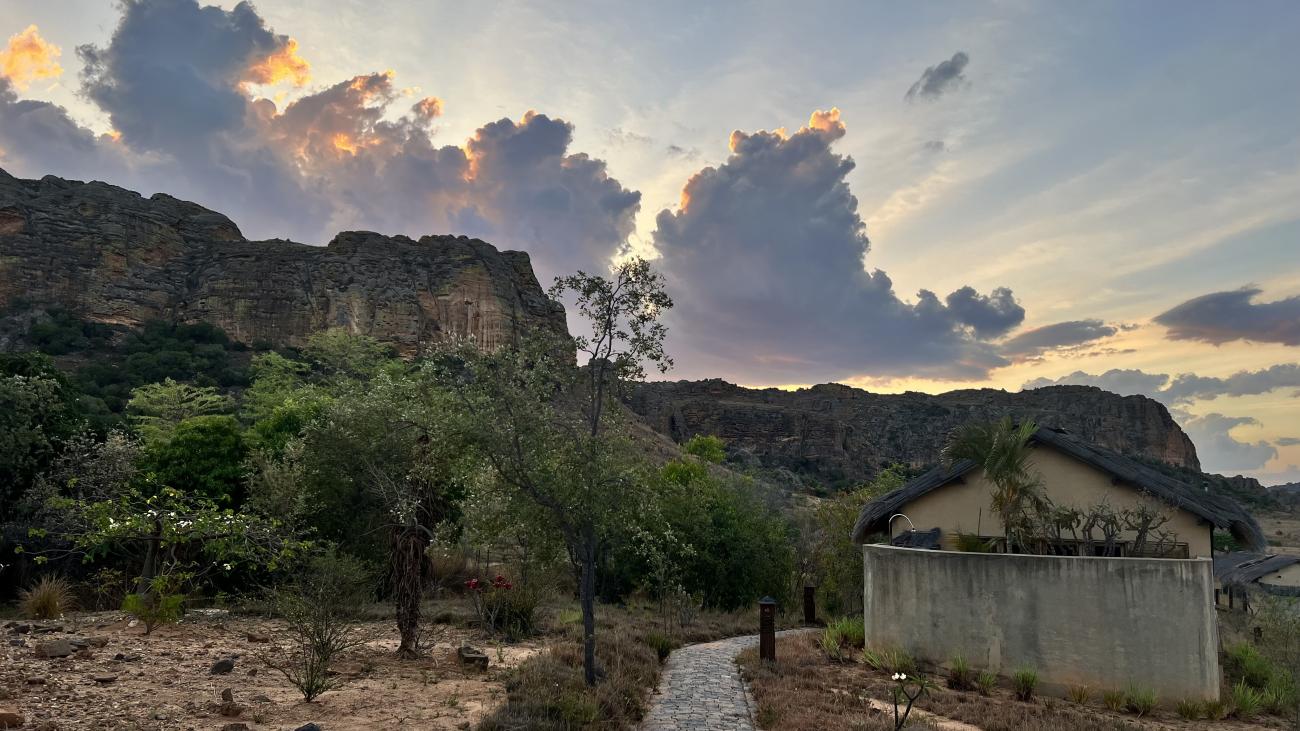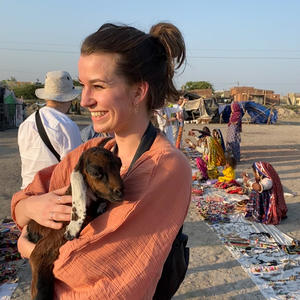What to expect on a trip to Madagascar
In a world where true off-the-beaten-track, adventure travel is getting harder to find, there’s always Madagascar…
The fourth largest island in the world, Madagascar defies and exceeds all expectations. Despite its location off the east coast of Africa, the paddy fields in and around the capital of Antananarivo are reminiscent of Vietnam, parts of the countryside look like rural France, and some landscapes, like the Horombe Plateau and Isalo National Park, evoke images of Mongolia. It’s believed the first settlers to arrive in Madagascar were Indo-Malayan seafarers, so the Malagasy language has roots in Indonesian, but also Arabic, Swahili and Hebrew. Many places are described as a ‘melting pot’ of cultures, but Madagascar more than deserves the title.
You can be sure to expect the unexpected in Madagascar, but some things are helpful to be aware of prior to travelling to the ‘Red Island’, so you can arrive suitably prepared and open to making the absolute most of your trip.
The long and winding (and bumpy) road
.jpeg)
There’s a lot of ground to cover on a Madagascar trip. Our Madagascar Encompassed group tour is three weeks long and takes in the iconic sights of the Avenue of the Baobabs and Tsingy National Park, characterised by the hostile-looking limestone pinnacles that white Decken’s sifakas adeptly use as their playground, softening their otherworldly appearance. Our Madagascar: Lemurs, National Parks & Coastlines tour is shorter by a week, and you’ll experience plenty of wildlife highlights and a range of other stunning national parks from east to west. With both tours, prepare for some long drives to reach these areas. Although the majority of the roads along these routes are well-paved, keep in mind that Madagascar is known to have some of the least developed road networks in the world, so there may be some rougher patches.
Depending on the group size, you’ll either travel in a large bus or a couple of 4WDs and while the drivers take good care in navigating potholes, it might be a challenging ride if you suffer from back problems or car sickness. A ‘Malagasy Massage’ isn’t for everyone.
Some transfers are more adventurous, perhaps in an overland truck to tackle some first-class dirt roads, so pack travel sickness pills or ginger chews if you're prone to motion sickness, but don’t let it put you off! This is the Wild Frontier's philosophy in (albeit bumpy) motion - the journey is just as good as the destination, and if that raw, old-school travel is your kind of travel, you’re in for a treat.
In Madagascar, they have a saying: ‘Mora Mora’ which means to slow down and take it easy, and this is the attitude you want to adopt in this country. It’s an undeniably beautiful place, but still a little rough around the edges so expect that cars can break down, plans can change and things can occasionally take longer than you might expect. Madagascar very much adheres to ‘island time’ so naturally requires a little flexibility, and ‘Malagasy flat’ is going to be, well, not that flat. But that’s what gives Madagascar its vibrant character - try and go with the flow and you might find that that ‘mora mora’ spirit is something you want to take home with you. After all, life moves too fast anyway…
Whatever the weather

Despite its location in the tropics, don’t expect tropical island heat and bright sunshine everywhere you go. Madagascar experiences many different climates. The central highlands can get quite cold, the east coast can experience a lot of rainfall and cyclones, the south-west is more arid and the west coast can be swelteringly humid. After extreme rainfall, some roads become impassable, so it’s important to check when the best time to visit Madagascar is and pack for all eventualities!
Fitness
.jpeg)
This is a destination that requires a certain level of fitness to enjoy to its maximum. It goes without saying that in Madagascar, the wildlife experiences are the stuff dreams are made of, and while you might get lucky enough to have the wildlife come knocking on your door (or jumping on your roof, or climbing up your walls), half the fun can be found in pulling on your walking boots and going out to meet it yourself.
Hikes can be adapted, so you can take it as ‘mora mora’ as you wish and there are routes that aren’t quite as challenging. But some will have you climbing steep steps and venturing along denser rainforest ‘paths’. The local guides are very good at looking after you and can always lend a helping hand so as long as you’re pretty sure-footed, they can find a route that is suitable for you.
These tours require a moderate level of fitness, and some people won’t find the hikes too strenuous, but the rainforest terrain, the humidity and the chance of rain can make paths a little slippery, so just bear this in mind.
Recommended packing:
- Good hiking boots
- Hiking poles
- A waterproof jacket
- Cooling fabric long-sleeved tops and leggings/long trousers for rainforest hikes
- LED lanterns for power cuts
- Hat and high-factor sunscreen
- Power banks - not all places you stay will have electricity at all hours
- A Water-to-Go filtered water bottle
Deforestation and poverty
.jpeg)
As Wild Frontiers travellers, we assume you won’t (massively) be basing your expectations of Madagascar on the animated movie, but just in case; yes you can expect dancing lemurs, you can even expect singing lemurs, but it’s not coast-to-coast rainforest you’ll find here.
Discovering the variety of landscapes will keep you intrigued on long journeys, but widespread habitat degradation and deforestation due to forest clearing for mining, slash-and-burn for agriculture and logging have recently led to Madagascar’s unique wildlife being confined to small fragments of their former habitats.
As one of the poorest countries in the world, most of the population lives on less than £1 a day, so it’s perhaps an idealistic notion to expect everyone here to prioritise the survival of the rainforest and its endemic species when they’re trying to survive themselves. It’s therefore important to have empathy for the complexity of the situation.
On our Madagascar: Lemurs, National Parks & Coastlines tour, we offer the opportunity to plant a tree at the Mitsinjo Tree Plantation Project near Antsirabe National Park towards the end of the trip, which is a lovely way to give back after seeing the effects of deforestation. It’s a small way to give back, but restoring the wildlife corridor and expanding the forest will help the ecosystem thrive.
Every year, from January to March, Malagasies across the country aim to plant 1,000,000 trees as part of school and community initiatives to counter the effects of deforestation. Madagascar was once known as the Green Island, and that’s exactly the title they’re trying to get back, one baby tree at a time.
Like in most destinations, the people of Madagascar will be keen to try to sell their wares to tourists to make some hard-to-come-by money. They may be persistent, but try to adopt a relaxed attitude to it. If you do want to buy, feel free to haggle but don’t drive too hard a bargain - having an easy-to-access guide on the conversion rates for ariary will help give you some perspective on what you are willing to spend on souvenirs.
It’s also very likely that you’ll encounter children begging along your journey. Outstretched hands and requests for bonbons and biscuits come frequently, but we discourage giving in this way - we don’t want to contribute to begging culture or poor dental health. It’s hard to resist their puppy-dog eyes but you’re doing them more favours by not acquiescing.
Animal welfare
.jpeg)
Madagascar’s flora and fauna are arguably amongst the country's biggest draws and as with any tour that centres around wildlife, we pay close attention to the impact of our presence. Unfortunately, but also perhaps understandably, you will encounter some people in Madagascar who capture and use the animals to make a profit.
If you’re approached with the opportunity to take a photo with a captured chameleon or any other animal, please refuse and report back to the tour leader. You don’t need to express your feelings to the person offering this opportunity, but our tour leaders can discourage it. When you create a demand, the animals will be used over and over again for the opportunity to make an income, to the detriment of all of the wildlife of Madagascar.
What can you expect from a trip to Madagascar?
As you’ll find travelling to any destination, the most useful thing you can do is to keep an open mind! Madagascar is a fascinating, unique place that will leave you feeling enriched and incredibly privileged to learn about all aspects of island life - from its variety of endemic flora, its endangered wildlife living freely in otherworldly landscapes to the fascinating cultural nuances of Madagascar’s friendly and welcoming people. Expect to feel the magic of Madagascar and you won’t be disappointed.
